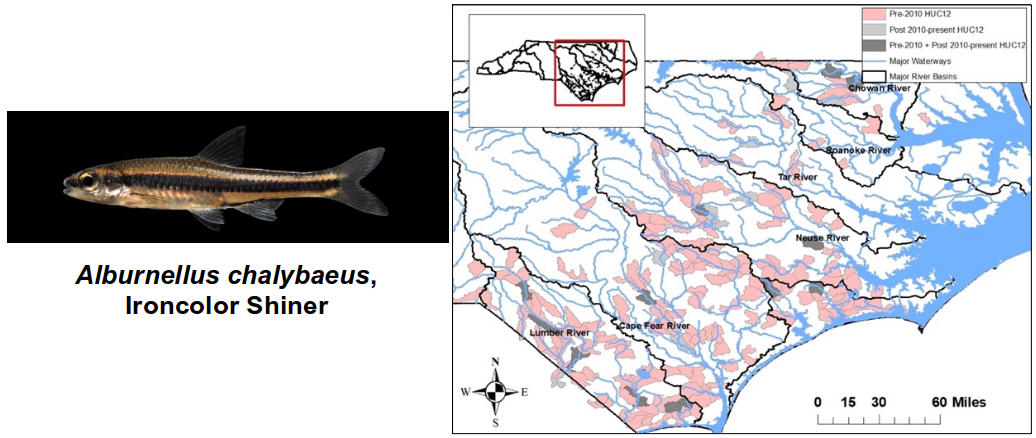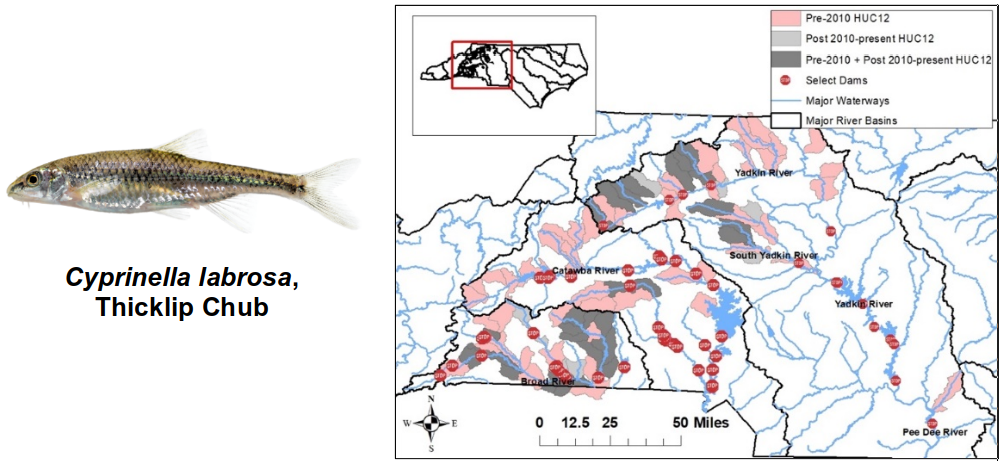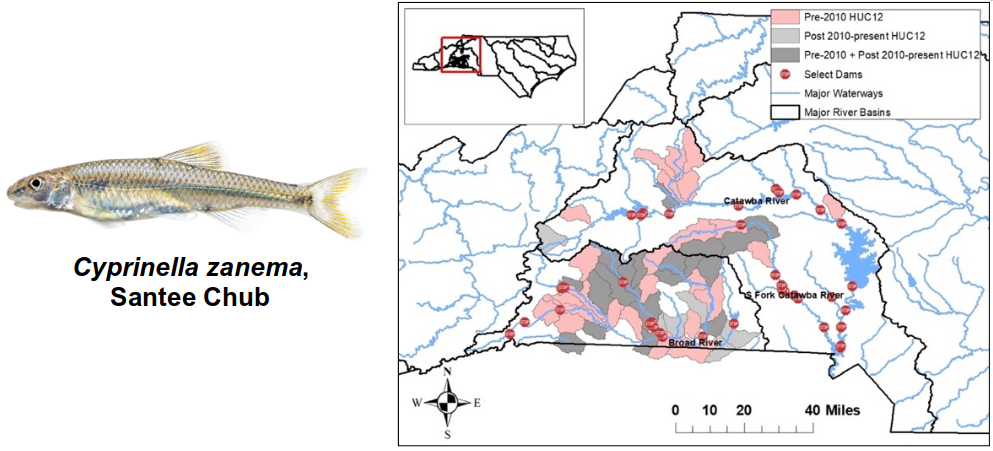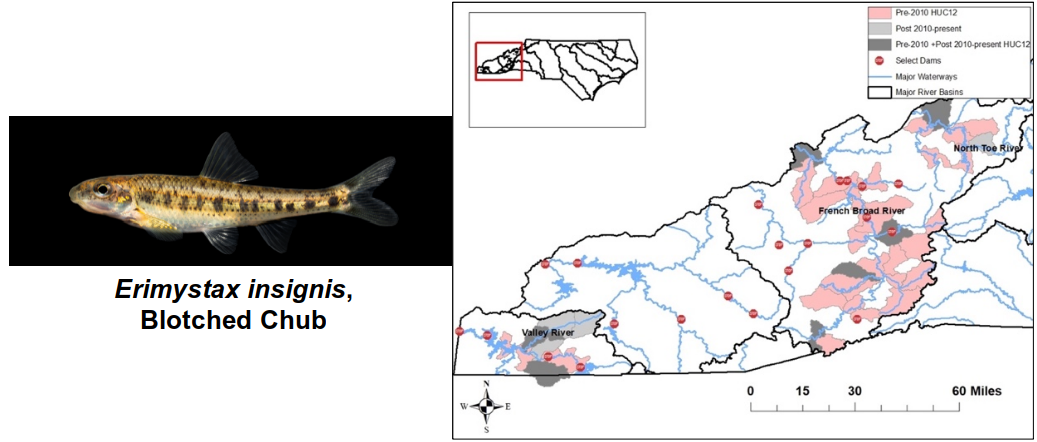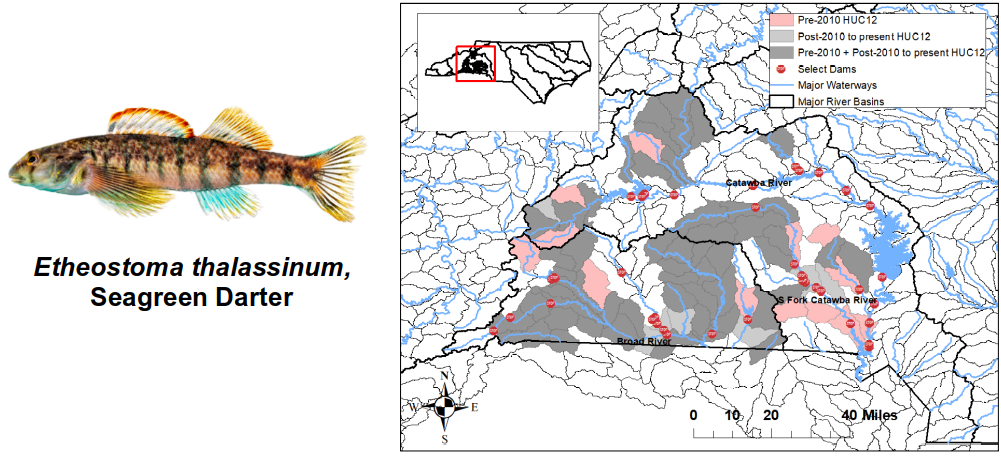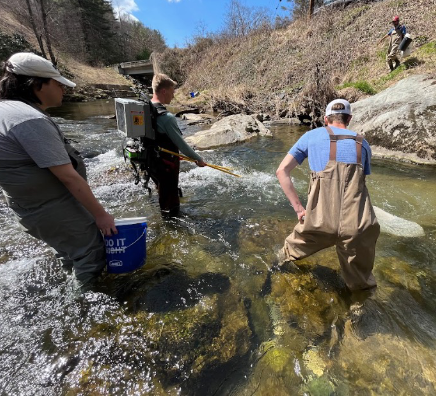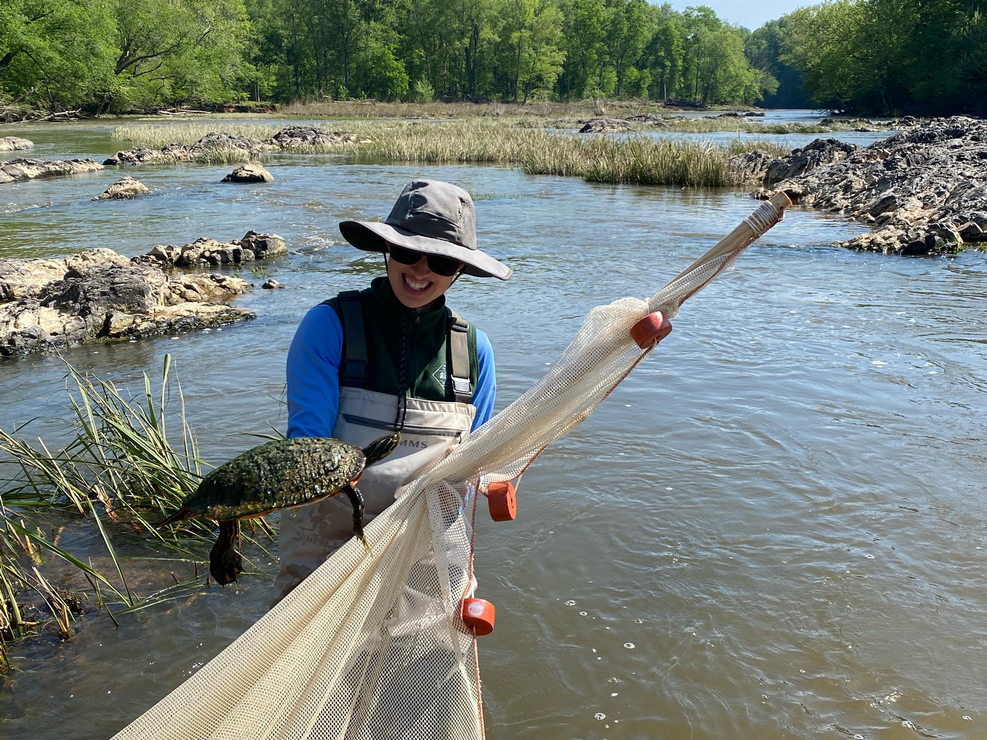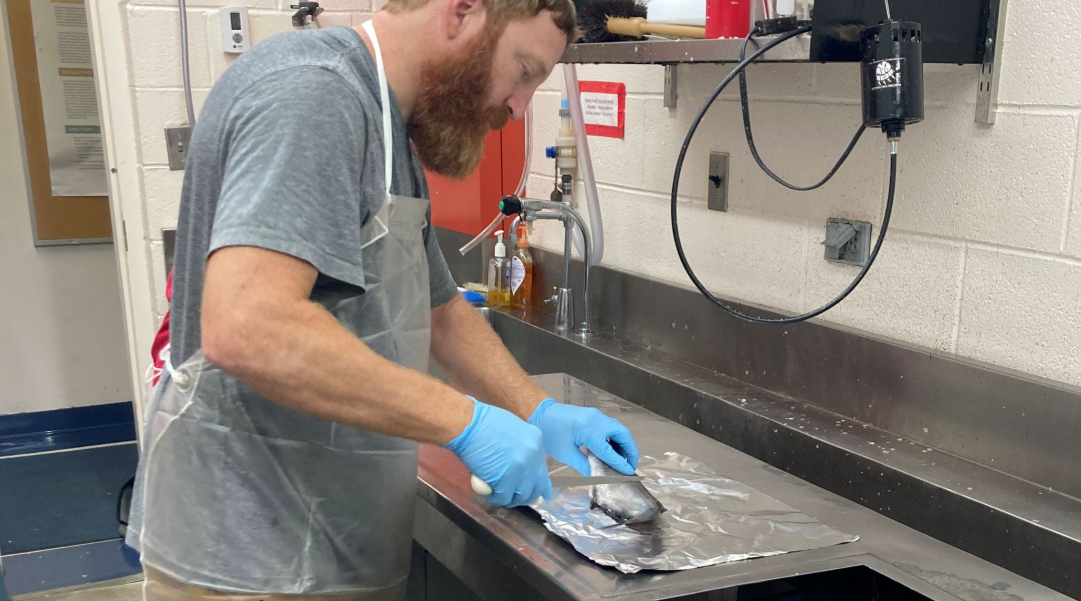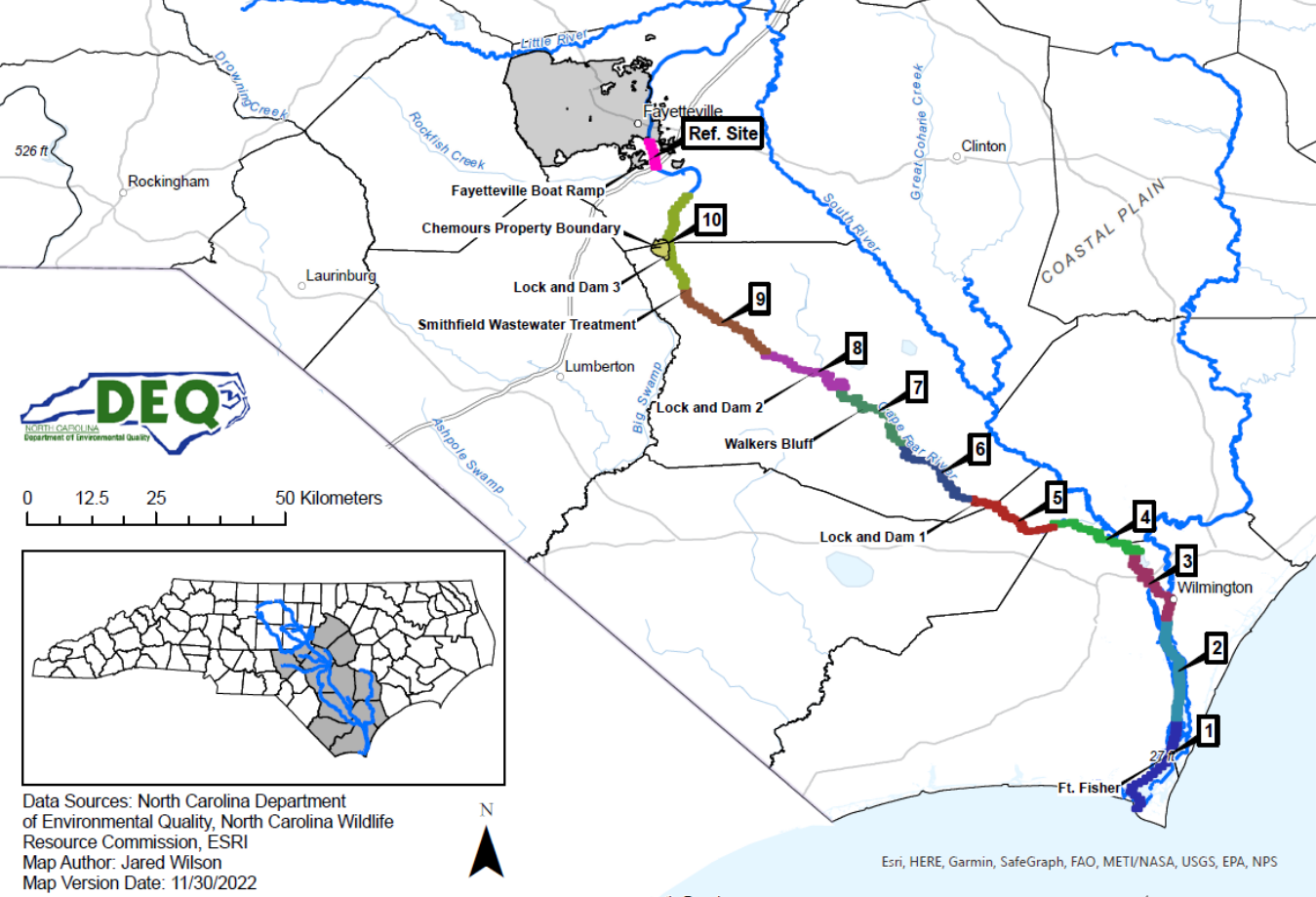Summer 2023 Newsletter

Quick Content Links
- President’s Message
- Treasurer’s Report
- Status Changes from the Freshwater Fishes Council
- Payne Branch Dam Removal Assessment
- Cape Fear Shiner Augmentation – Part II
- Characterization of PFAS in sport fish species in the Cape Fear River
- Good Work! – Recent Publications by NCAFS Members
- Stories of Interest
- Call to Action!
- Valuable Links
President’s Message
As we enter my favorite time of year, I find myself looking forward to my least favorite time of year, February! I am speaking, of course, of SDAFS 2025 which has officially been booked for February 17–21, 2025 at the Renaissance Hotel in Asheville, NC. Our planning committees are taking shape and we are sincerely looking forward to showcasing our state and our chapter at this meeting. As we move forward in the planning process, we encourage members to reach out to Jessica Baumann or me with any ideas for symposia, workshops, socials, or events. And I know I sound like a broken record at this point, but if you want to volunteer your service it is never too late to volunteer for SDAFS 2025.
I hope everyone enjoys the rest of their summer!
Kelsey
Submitted by Kelsey Roberts, NCAFS President
Treasurer’s Report
Balances as of June 12, 2023
NCAFS Wells Fargo Checking Account: $4,930.98
NCAFS PayPal Account: $58.61
RRCC Wells Fargo Saving Account: $7,130.58
Edward Jones Ichthus (Student) Fund: $29,360.38
Edward Jones General Fund: $63,454.46
As of June 2023, the NC Chapter of the American Fisheries Society has a total of 42 NC AFS only members and 77 NC AFS and AFS members for a total of 119 active members. 20 are students, 86 are professional members, and 13 are retirees or lifetime members. Thank you to everyone who paid their dues!
Recent monetary transactions within our chapter include a deposit paid for the 2025 SDAFS meeting and a reimbursement from AFS for membership dues. We are also looking to hopefully sponsor a few students to attend meetings in the near future!
For a detailed report of NCAFS’s finances in 2022, and other chapter information, please reference the 2023 Business Meeting Minutes, available on our website for review. For any questions regarding meeting minutes, finances, or procedures, please contact Casey Joubert, Secretary/Treasurer for NCAFS ([email protected]).
Casey
Submitted by Casey Joubert, NCAFS Secretary-Treasurer
Status Changes from the Freshwater Fishes Council
A Scientific Council, of which there are six—Mammal, Bird, Reptile and Amphibian, freshwater Fish, freshwater Mollusk, and freshwater Crustacean—is a “group of scientists identified and assembled by the [Nongame Wildlife] Advisory Committee to review the scientific evidence and to evaluate the status of wildlife species that are candidates for inclusion on a protected animal list” (NCWRC 2020). The Freshwater Fishes Council is composed of the following six members: Luke Etchison and J. Michael Fisk (North Carolina Wildlife Resources Commission [NCWRC]), Ryan J. Heise (Duke Energy), Gabriela M. Hogue (North Carolina Museum of Natural Sciences [NCSM]), Fred C. (Fritz) Rohde (National Oceanic and Atmospheric Administration), and Bryn H. Tracy (retired, North Carolina Division of Water Resources [NCDWR], Research Adjunct, NCSM).
The NCWRC Nongame Wildlife Advisory Committee has charged the Freshwater Fishes Council to: “Review the status listings of freshwater fish species, and, where warranted, to recommend changes in status listings that are based on the best scientific evidence available to you and your council colleagues” (Dr. W. David Webster pers. comm.). Recommendations of the Council are forwarded to the NCWRC Nongame Wildlife Advisory Committee who approve or disapprove the recommendations before passing them on to NCWRC’s Habitat, Nongame & Endangered Species Committee of Commissioners and ultimately to the NCWRC Commissioners’ Committee of the Whole. The process continues forward to public meetings, the North Carolina Office of Administrative Hearings, the North Carolina State Rules Committee, and ultimately to adoption and publication in the North Carolina Administrative Code (NCAC). The recent recommendations took approximately three years to navigate their way from the Council to being adopted and published in the NCAC.
Each Council uses the North Carolina Species Assessment Tool to determines a species’ recommended conservation status (NCWRC 2020). The tool is a modification of the International Union for the Conservation of Nature Red List Protocol and is designed to make the state-listing process more objective, consistent, and quantifiable across all animal groups (NCWRC 2020). Species are chosen for review based upon requests from Council members, NCWRC staff, or from petition by the public. To our knowledge, the Council has yet to receive a petition from the public. During the current review, Council members chose one species from 2 of the 3 primary physiographic regions in North Carolina: Mountains (Blotched Cub, Erimystax insignis) and Coastal Plain (Ironcolor Shiner, Notropis chalybaeus, now known as Alburnops chalybaeus). The initial review process proceeded so smoothly that three additional species from the Piedmont were also reviewed: Thicklip Chub, Cyprinella labrosa, Santee Chub, C. zanema, and Seagreen Darter, Etheostoma thalassinum. Each of these five species’ level of impairment was previously classified by NCWRC as “Not Listed”.
Data Sources
For each species, the “extent of occurrence” was calculated for both historical and current distributions. Historical distribution was defined as all captures through 2010 and was based on NCWRC sampling records and data from the Academy of Natural Sciences of Drexel University, American Museum of Natural History, Auburn University Museum, California Academy of Sciences, Cornell University Museum of Vertebrates, Florida Museum of Natural History, Illinois Natural History Survey, National Museum of Natural History, NCDWR, NCSM, Ohio State University Museum, Roanoke College Ichthyological Collection, Royal Ontario Museum, Tulane University, University of Alabama Ichthyological Collection, University of Kansas, University of Michigan Museum of Zoology, University of Alabama Ichthyological Collection, University of Kansas, University of North Carolina-Charlotte, University of Tennessee – Etnier Ichthyological Collection, and Virginia Institute of Marine Sciences. Museum records were compiled from accessible material accessed through the FishNet2 Portal (http://www.fishnet2.net/, 2018-2020) or through direct contact with institutional staff (Tracy et al. 2020). Current distribution was defined as all captures from 2011–present and were based on surveys conducted by NCSM, NCWRC, NCDWR, University of Tennessee,Yale Peabody Museum of Ichthyology, NCWRC permit holders, and data submitted to NCWRC’s Portal Access to Wildlife Systems.
Extent of occurrence was calculated based on the guidelines of the North Carolina State Listing Handbook (NCWRC 2020). Using geographical spatial analyses, the total area of all USGS HUC12s (https://nas.er.usgs.gov/hucs.aspx) which the species historically occupied were compared to the total area of all HUC12s which the species currently occupies. Below is the visual representation of the data for the five species (arranged in alphabetical order by scientific name) that were reviewed:
Results
Two white papers were written for each species, for example: “A North Carolina Species Assessment Tool for the Santee Chub, Cyprinella zanema, and “Species Summary Sheet for the Santee Chub, Cyprinella zanema (these public papers are available upon request from the Council). Both white papers included a map of the current and historical distribution of each species and the Species Summary Sheet contained a paragraph entitled “Rationale for Status Change” (Table 1).

Table 1. Rationale for status change for five fish species according to NC Species Assessment Protocol (NCWRC 2020).
Based upon the analyses, the Council concluded that each of the five species met the designated Geographic Range criterion under the North Carolina Species Assessment protocol to be uplisted from “Not Listed” to state Threatened. According to NCWRC (2021), a Threatened species is defined as: “any native or once-native species . . . which is likely to become an Endangered species within the foreseeable future throughout all or a significant portion of its range, or one that is designated as a Threatened species pursuant to the [federal] Endangered Species Act”. The thresholds for listing as state Threatened are a current extent of occurrence reduction of ≥ 50% OR an extent of occurrence < 5,000 km2, which is about 2.25 X the size of Wake County (Table 2).

Table 2. Geographic ranges of five fish species according to NC Species Assessment Protocol (NCWRC 2020).
Suspected Causes of Imperilment
The causes of imperilment for any of these five stream-dwelling species should not be new to anyone who has studied North Carolina’s aquatic communities: 1) habitat fragmentation, truncated distributions, and isolated subpopulations with no gene flow between subpopulations because of the historical construction of dams; 2) population growth, urbanization, and land use alterations in the Piedmont and Mountains in the vicinity of metropolitan Charlotte, Hickory, Asheville, and Henderson; 3) confined animal feeding operations and land use alterations, including agricultural runoff and lagoon spills, throughout the Coastal Plain; 4) hydrologic impacts from recurrent and stronger hurricanes and tropical storms; and 5) point and nonpoint source pollution.
Postscript
Between 2022 and 2023, NCWRC staff reviewed the recommendations that had been made by the Freshwater Fishes Council and which had been previously submitted for approval to the North Carolina Nongame Advisory Committee. NCWRC staff largely supported the Council’s recommendations. However, there was one instance where the Council’s recommendation was not supported by NCWRC staff. They concluded that the Seagreen Darter merited uplisting to Special Concern rather than to Threatened listing because the Extent of Occurrence had only undergone an 11% reduction even though its current range is less than 5,000 km/sq which did meet the criterion for being a Threatened species. A Special Concern Species status is defined as: “any species native or once native . . . which is determined . . . to require monitoring but which may be taken under regulations adopted under the provisions of this Article” (NCWRC 2021).
Conclusion
Effective February 01, 2023, Thicklip Chub, Santee Chub, Blotched Chub, and Ironcolor Shiner were designated as State-listed Threatened species; Seagreen Darter was designated as State-listed Special Concern species (NCAC 2023).
References
North Carolina Administrative Code (NCAC). 2023. Subchapters 10I. 0103 – 10I. 0105 – Endangered, Threatened, and Special Concern Species Listed. Amended effective February 1, 2023. Printed March 1, 2023. North Carolina Administrative Code. Raleigh, NC.
North Carolina Wildlife Resources Commission (NCWRC). 2020. North Carolina endangered, threatened, and special concern species. Listing Handbook. A guide for placing fish and wildlife species on the North Carolina Protected Animal List. North Carolina Wildlife Resources Commission, Raleigh, NC. 24p.
North Carolina Wildlife Resources Commission (NCWRC). 2021. Protected wildlife species of North Carolina. October 1, 2021. North Carolina Wildlife Resources Commission, Raleigh, NC. 10p.
Tracy, B. H., F.C. Rohde, and G.M. Hogue. 2020. An annotated atlas of the freshwater fishes of North Carolina. Southeastern Fishes Council Proceedings No. 60. 198p.
Acknowledgements
Photographs courtesy of the NCFishes.com team.
Note: This article updates the presentation: “The North Carolina Freshwater Fishes Council – An Update on Status Listings” given by Council staff at the 34th Annual Meeting of the North Carolina Chapter of the American Fisheries Society, February 22-23, 2023, Durham, NC.
Submitted by Bryn H. Tracy, Chair, Freshwater Fishes Council
Payne Branch Dam Removal Assessment
Payne Branch Dam, positioned along the Middle Fork New River, was deconstructed in 2020. The deconstruction project was part of an effort to restore and conserve stretches of the New River and extend a greenway trail connecting the towns of Boone and Blowing Rock. Historically, the stream has supported over 20 species of fish including New River drainage endemics such as Kanawha Darter, Etheostoma kanawhae, and Kanawha Minnow, Phenacobius teretulus. However, a water treatment plant spill resulted in the death of over 14,000 fish and extirpated some species above the dam. With the removal of the dam, it was theorized that downstream populations of these species could begin migrating upstream and re-colonize the habitat above the historic dam site. Backpack electrofishing surveys were conducted at five historically sampled sites to assess the occurrence of recolonization.
For my Honors Thesis, I collaborated with Dr. Michael Gangloff to assess fish community change after dam removal. Data collected in 2014 (pre dam removal) was used to compare to 2023 data in order to evaluate the impact of the dam removal. Spring 2023 data demonstrated that recolonization of upstream habitat has not yet to occurred. Habitats downstream of the former dam site demonstrated increased species richness, greater Shannon-Weiner Diversity, and an increase in endemic species present. However, upstream habitat did not demonstrate the same improvement. The community seemed relatively unchanged compared to pre-dam removal assessments. Despite the Shannon-Weiner diversity slightly increasing, species richness decreased, and two endemic species sampled in 2014 were not observed in 2023. This could be due to the high gradient of river just downstream of the dam site, possibly restricting migration and acting as a natural barrier. Translocation may be needed to facilitate the colonization of upstream habitat; however, more data may be required to develop a recolonization plan.
Submitted by Nick Campany, Appalachian State University
Cape Fear Shiner Augmentation – Part II
On the morning of April 20, 2023 under a beautiful Carolina-blue sky, Chapter members (Jennifer Archambault & Brandi Symons – USFWS; Trevor Hall & Tom Dickinson – Three Oaks Engineering; Katharine DeVilbiss, Brena Jones, Vann Stancil, & Isabella Scheibl – NCWRC; Chris Sheats – Transystems, Inc.; and Bryn Tracy) under the tutelage of Brena Jones participated in the second round of collecting Cape Fear Shiner (Miniellus mekistocholas, formerly known as Notropis mekistocholas) brood stock for propagation at the USFWS Edenton Fish Hatchery. The releases following the first round were highlighted in the Winter 2022 NCAFS Newsletter (https://nc.fisheries.org/winter-2022-newsletter/ – Cape_Fear_Shiner_Augmentation).
As many Chapter members know, or should know, the Cape Fear Shiner (Figure 1) is a federally listed endangered species found nowhere else in the world except for a very restricted distribution and precarious existence in central North Carolina (Figure 2).
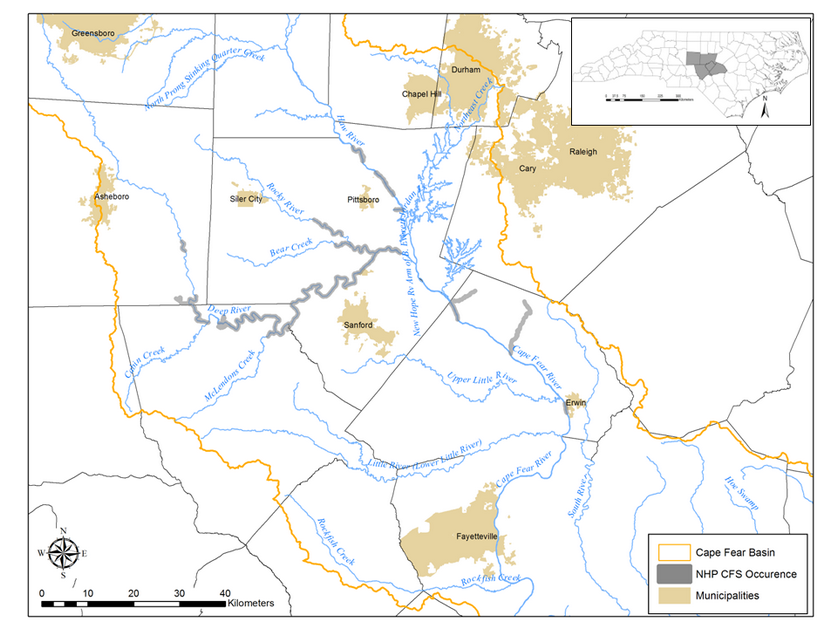
Figure 2. Distribution of Cape Fear Shiner in North Carolina in 2019. Map created by Brena K. Jones.
With high flows in the Deep and Rocky rivers thwarting an attempt approximately two weeks prior, the crew decided to try it again under more favorable conditions just downstream from the confluence of the Rocky River with the Deep River. Even though the two rivers looked fairly muddy from a bird’s eye view (Figure 3) instream visibility wasn’t all that bad.
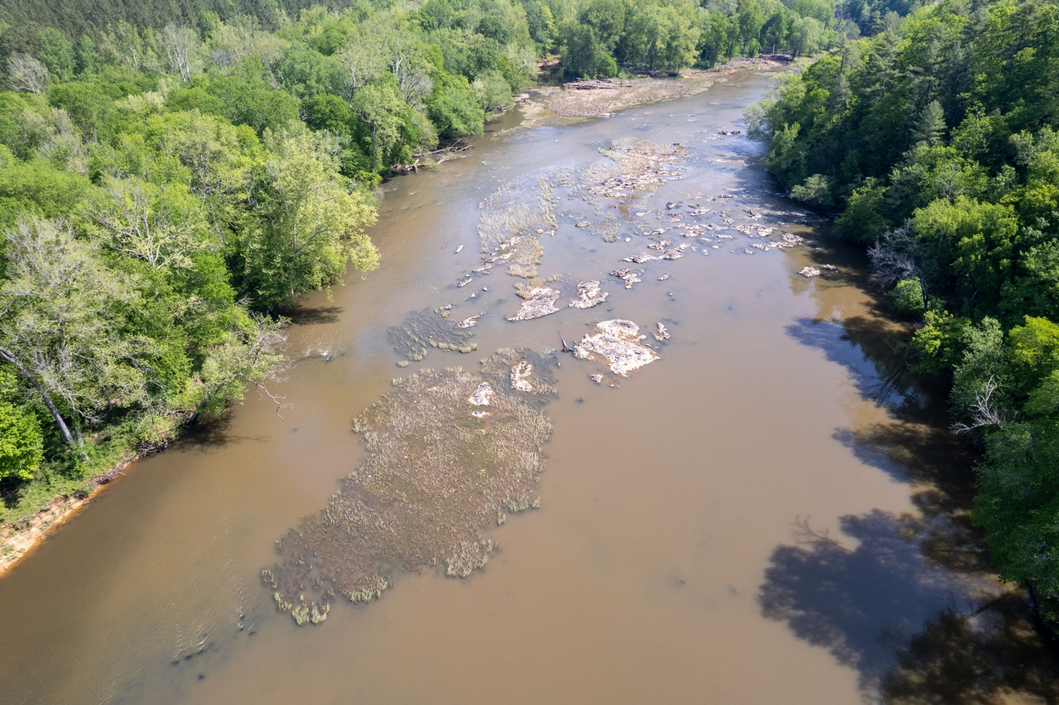
Figure 3. Just downstream from the confluence of the Rocky River (lower left) and Deep River, April 20, 2023. Island with beginning spring growth of Water Willow, Justicia americana, is in the foreground. Drone photograph by Vann Stancil.
Using two 10-12 ft. minnow seines, the two crews made quick work of the collection of about 100 mature and immature specimens from some of the species’ favored habitats: areas with new growth of Water Willow, Justicia americana, and last year’s aquatic grasses and sedges (Figure 4).
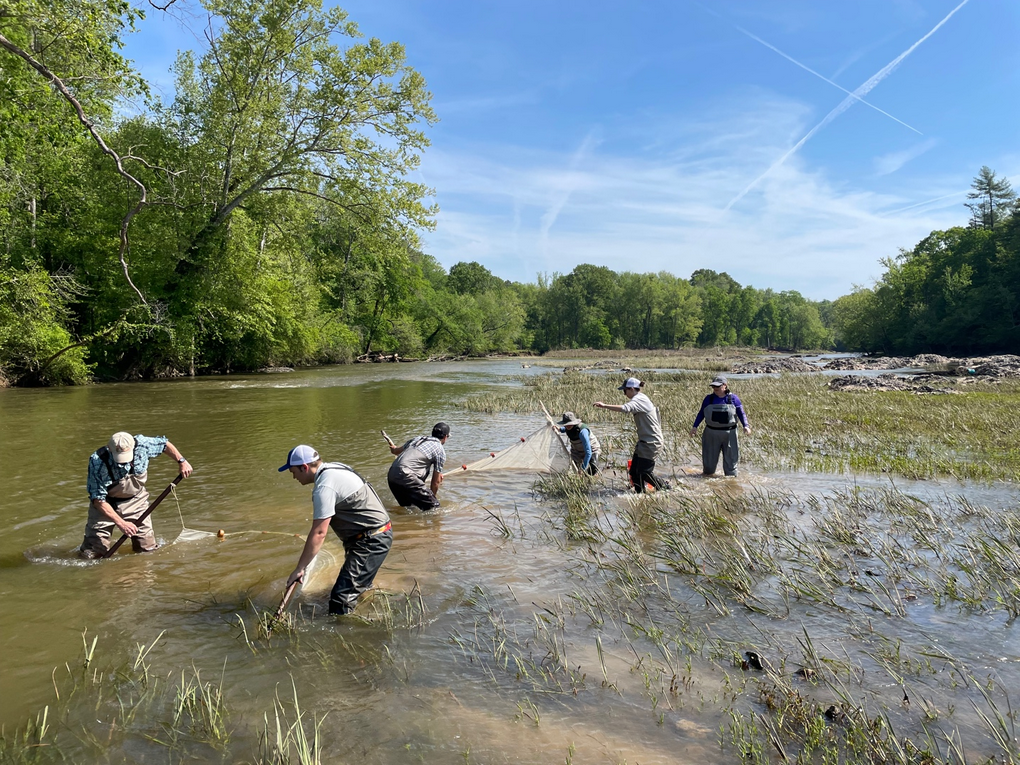
Figure 4. Crews seining the Deep River for Cape Fear Shiner, April 20, 2023. Photograph by Chris Sheats.
Some of the mature specimens were already starting to show the golden yellow breeding colors for which they are famous. Other vertebrates encountered that morning included Sandbar Shiners, Notropis scepticus, White Shiners, Luxilus albeolus, and an algae-encrusted slider (Figure 5).
After sorting and counting the specimens, the fishes were transferred to the hatchery truck where they comfortably traveled to Edenton, NC. After acclimation to their spawning aquaria, they quickly showed off their characteristic black chin stripe (Figure 6), confirming to the crew that they had indeed collected the right species. Now, the next step in this project is for the fish to do what they should do at this time of year so that their young-un’s can augment the Cape Fear River population later this year.
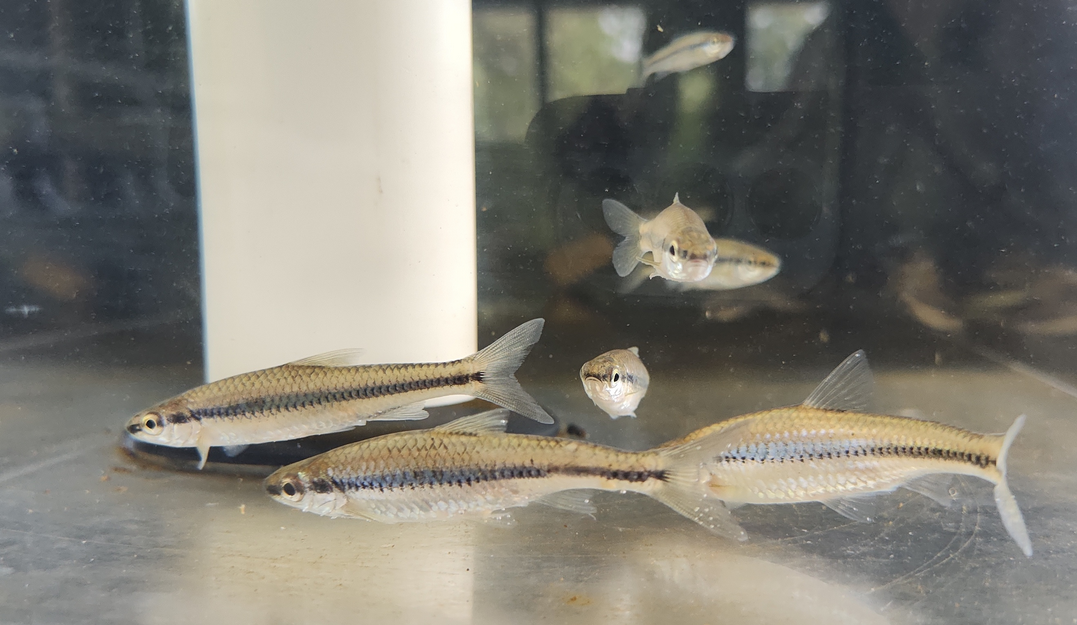
Figure 6. Cape Fear Shiner making themselves at home at the USFWS Edenton Fish Hatchery. Photograph by Brandi Symons.
Submitted by Bryn H. Tracy and Brena K. Jones
Characterization of PFAS in sport fish species in the Cape Fear River
In 2022, the NC Department of Environmental Quality (NCDEQ) initiated a multi-agency investigation into per- and polyfluoroalkyl substances (PFAS) in fish in the Cape Fear River. A class of synthetic chemicals that includes thousands of known compounds, PFAS are released into the environment from many sources including industrial emissions, municipal wastewater, and aqueous film-forming foams. Due to their strong carbon–fluorine bond, these compounds are stable in the environment and generally do not degrade in biologically relevant time scales. The goals of the investigation were to identify PFAS compounds in recreationally important fish species in the Cape Fear River, improve understanding of PFAS bioaccumulation across trophic levels, and to inform the development of fish consumption advisories.
From June through August 2022, over 250 fish from 14 species were collected by the NC Wildlife Resources Commission (NCWRC), NC Division of Marine Fisheries (NCDMF) and NCDEQ. Collections occurred in each of ten 20-km strata downstream of a known historical PFAS industrial source and in one reference site located upstream of the historical source. Species collected in each freshwater site included Bluegill (Lepomis macrochirus), Largemouth Bass (Micropterus salmoides), Redear Sunfish (L. microlophus), Blue Catfish (Ictalurus furcatus), and Flathead Catfish (Pylodictis olivaris). Additionally, American Shad (Alosa sapidissima), Striped Bass (Morone saxatilis), and Channel Catfish (I. punctatus) were collected from several sites where they were aggregated. Surface water was collected at each fish collection site, and fish fillets were processed using established NCDEQ procedures. Surface water and fish muscle tissue were analyzed for 56 different PFAS including novel compounds that are unique to one or more industrial sources as well as legacy compounds with widely distributed sources.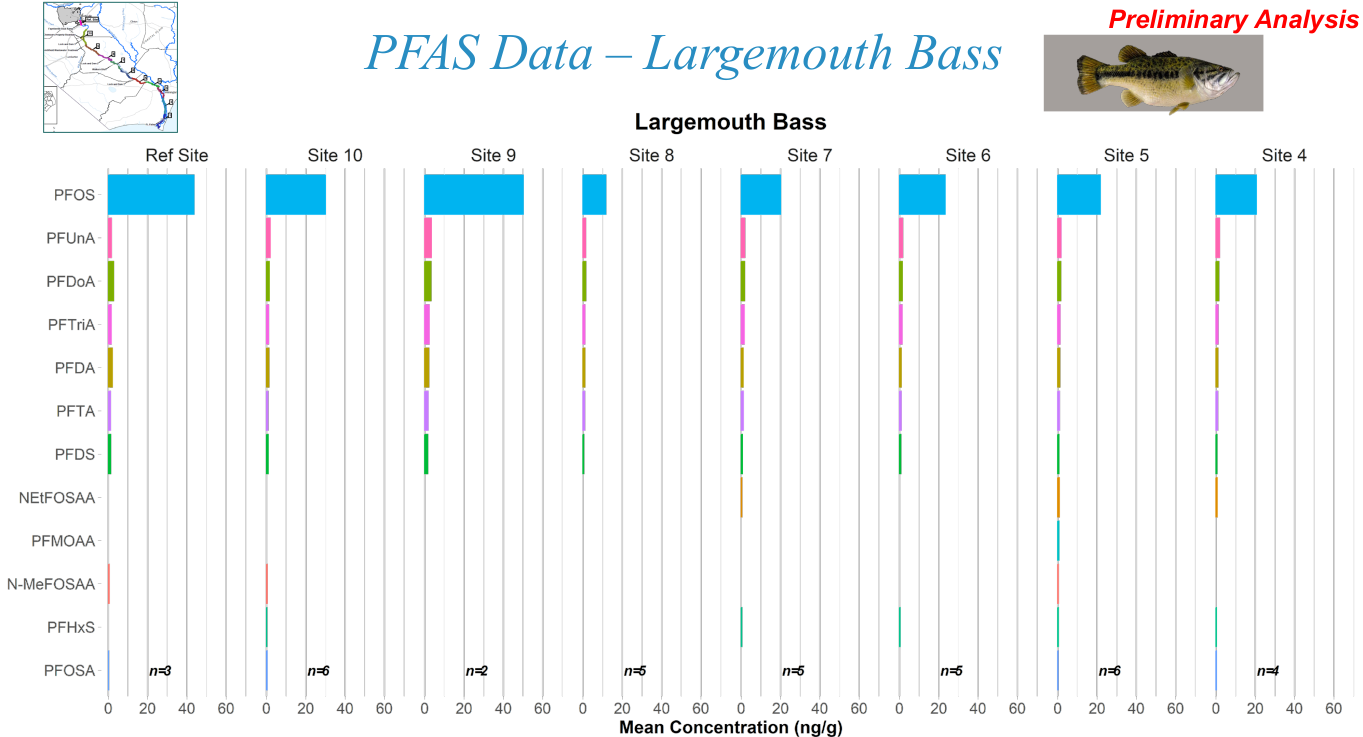
Preliminary results indicate the dominant PFAS compound in fish muscle tissue was PFOS. Largemouth Bass contained the greatest concentration of PFOS with mean site concentrations as high as 50 ng/g. American Shad, Blue Catfish, and Channel Catfish had the least accumulation of PFOS, generally with mean concentrations less than 5 ng/g. Dozens of other PFAS compounds were present in detectable levels, though the compounds detected varied by species. For example, 15 different PFAS compounds were detected in Redear Sunfish while 6 were detected in American Shad. Bioaccumulation of PFOS did not appear to demonstrate spatial trends and fish size was not significantly correlated with PFOS concentration.
Work is ongoing to characterize PFAS in estuarine and marine fish species in the lower Cape Fear River, and additional fish collections are anticipated to better characterize spatial components and physiological impacts. Additionally, the NC Department of Health and Human Services (NCDHHS) is reviewing the data to inform fish consumption advisories.
Additional information is available in this presentation provided to the NCDEQ Secretaries’ Science Advisory Board.
Submitted by Frannie Nilsen (DEQ Environmental Toxicologist) and Kyle Rachels
Good Work! – Recent Publications by NCAFS Members
Bell, G. W., and D. B. Eggleston. 2023. Timing and route of migration of mature female Blue Crabs in a large wind-driven estuary. Transactions of the American Fisheries Society 152(2):253-269.
Craig, J. K., K. B. Huebert, K. A. Rose, J. A. Rice, and D. C. Brady. 2023. Searching for oxygen: dynamic movement responses of juvenile Spot (Leiostomus xanthurus) in an intermittently hypoxic estuary. Estuaries and Coasts 46:772-787.
Doll J.C., L. Etchison, and D. Owensby. 2023. State-space models to describe survival of an endemic species in the Little Tennessee River basin. Frontiers in Ecology and Evolution doi.org/10.3389/fevo.2023.1097389.
Fogelman, K., J. M. Archambault, E. Irwin, M. Walsh, S. Brewer, and J. A. Stoeckel. 2023. A review of lethal thermal tolerance among freshwater mussels (Bivalvia: Unionida) within the North American faunal region. Environmental Reviews https://doi.org/10.1139/er-2022-0077
Perkins, M. A., B. W. Williams, and W. T. Russ. 2023. Integrative taxonomy reveals two new narrowly-endemic crayfish species (Decapoda: Cambaridae) from the Yadkin River Basin in western North Carolina, USA. Zootaxa https://doi.org/10.11646/zootaxa.5270.2.3.
Rogers, J. J., W. F. Henley, A. G. Weberg, J. W. Jones, and W. G. Cope. 2023. Histological evaluations of organ tissues reveal sub-lethal effects in a freshwater mussel (Villosa iris) exposed to chloride and potassium concentrations below benchmark estimates. Aquatic Toxicology. 258: Article 106476, 9 pp.
Whelan, N. V., N. A. Johnson, A. S. Williams, M. A Perkins, C. E. Beaver, and J. W. Mays. 2023. Hidden in the hills: phylogeny of the freshwater mussel genus Alasmidonta (Bivalvia: Unionidae) and description of a new species. Zoological Journal of the Linnean Society 198(2):650-676.
Submitted by the NCAFS Newsletter Review Team
Stories of Interest
Edward F. Menhinick
The passing of ichthyologist and noted author of “The Freshwater Fishes of North Carolina”
Waters of the United States
SCOTUS ruling significantly reduces Waters of the United States
Black Bass in North Carolina
Thanks to the efforts of several chapter members, NCWRC rolled out new material on black bass
Recovering America’s Wildife Act
Bill reintroduced in US Senate and co-sponsored by NC’s Tillis
Aquatic Invasive Species Commission
Collaborative report on mitigating AIS issues
Proposed NC House Bill 600 would weaken environmental protections
NCDEQ would be prohibited from adopting PFAS surface water regulations
Bahamas conch fishing
Overfishing threatens a way of life
Freshwater crustacean not listed
USFWS determines Chowanoke Crayfish not threatened or endangered
Unwelcome visitors
WINC article on several invasive species in NC
The better bass waters
Chapter members talk about a few of NC’s best bass fisheries
Invasive Carp
Overview of carp control methods
Coalition nears funding goals for dam removal
Over 80% of funds acquired to remove Ela Dam
The fish wars
Challenges to marine fisheries management in NC
Dam building spree in the Amazon
Connectivity challenges in the world’s largest river system
Submitted by the NCAFS Newsletter Review Team
Call to Action!
If you want to contribute, have a story idea or would like us to include something in next quarter’s newsletter, email Kyle Rachels at [email protected] or give him a call at 252-548-4938.
Also, if you want to become more involved with one of the many great NCAFS committees then please check this link for information about each one, contacts, etc., https://nc.fisheries.org/who-we-are/committees/
 Valuable Links
Valuable Links
The American Fisheries Society Home Page offers a wealth of links to assist you in your fishy endeavors. This and archived NCAFS newsletters, along with links, chapter information, and upcoming meetings, can be found here on our own website.

